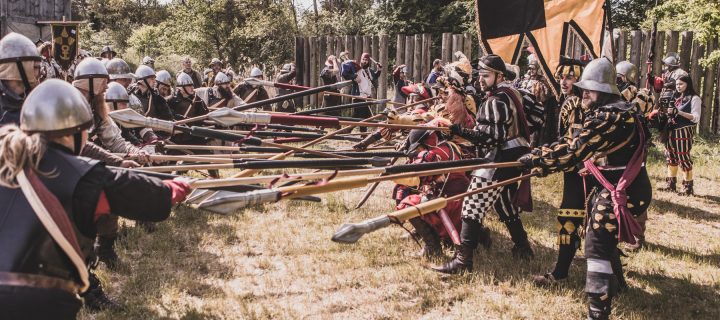The first time I participated in Krigslive in 2011, I was 16 years old, and despite the mud, the bruises, and the bad sleep, it was one of the best and most immersive larp experiences of my life. I was enraptured by the thrill of the battlefield. The adrenaline and bloodlust made me fearless to storm players twice the size of my short, skinny teenage self alongside my likewise skinny, teenage brothers and sisters in arms. At that larp, in those moments, I forgot the real world, and I was at one with the experience of a warrior in battle.

The author (centre) at Krigslive 7 in 2011, unknown photographer
Today I am 28 (which in the Danish larp community is ancient). I have organised one Krigslive by myself and co-organised the most recent (in 2023) with my 19-year-old co-organiser, Tobias Ritzau, for a record-breaking number of participants. My favourite larp of all time is older than ever, and alive and kicking.
What is Krigslive?
Krigslive is a Danish battlelarp, that was first organised in 2006 by Thomas Aagaard (but there were other similar smaller events preceding and inspiring this event). Since then, it has been organised approximately yearly, and Krigslive XVIII took place in 2023.
A battlelarp is a larp where battles and fighting with boffer weapons takes center stage and is the main source of entertainment and action. Other examples of battlelarps are DrachenFest and Conquest of Mythodea in Germany, Krigshjärta (Eng. War Heart) in Sweden and Sotahuuto (Eng. War Cry) in Finland.
A number of things make Krigslive unique as a battlelarp. It is inspired by the Warhammer Fantasy tabletop miniature games, and the rules of Krigslive reflect that. The rules are revised each year by the new organisers, effectively making it a collective creation in its 18th iteration. The rules are the core of the Krigslive formula, as the setting of the larp can change (although it is most often Warhammer Fantasy). They were contained in a few pages in the beginning and have by now developed into a text of 16+ pages. They centre the principle of “fighting in formation”; that all members of a unit must stay within an arm’s reach of each other during battle. If you are separated from your unit and cannot immediately rejoin, you are demoralised and destroyed. If a unit is split in two, the part that stands with the banner survives and the other is destroyed. If a unit falls below five people (including bannerman) they are demoralised and destroyed. Everyone in a unit must carry the same weapons and armour, be visually distinguishable as a unit, and they have the same hit points from the onset of the battle. Everyone is individually responsible for counting their own hit points as they diminish. These rules structure the battles and promote cooperation within the groups.
The rules are published on the website prior to the game, and also sent out in participants’ letters. At the last Krigslive a simplified one-page version of the rules was made and posted on the inside of the bathroom stalls. Many veteran players have developed a strong memory of the rules. Krigslive organisers have less agency to design their event because players have such a strong sense of ownership over the concept. A common disagreement (and source of organiser stress) between organisers and players is the introduction of new rules or alteration of old ones. Likewise, a common disagreement between players is when old rules from old iterations are thought to still be in use.

General von Liebwitz, played by Carl Munch (22), Krigslive 18 in 2023, photo by Rekografia
The larp focuses on portraying soldiers at war; usually there are two enemy camps at the location, and there has thus far never been an in-game town. Krigslive is organised as a relay within the Danish larp community; different larp organisers from different Danish larp organisations take turns organising Krigslive. Newer organisers are prioritised over ones that have organised Krigslive before. To date there are more than 20 former Krigslive organisers (sadly, two have passed away). I love this relay structure because it gives everyone the opportunity to organise Krigslive, and it gives the whole community ownership. However, it has been difficult at times to recruit new organisers, or any organisers at all, and it is sometimes a very stressful experience to be a Krigslive organiser. Although the organiser(s) do not need to spend a lot of time on recruitment, they do have to navigate a community that has very strong and sometimes conflicting expectations of what Krigslive and its rules should be.
Krigslive has no individual characters. Everyone participates as part of a group, and groups organise all their tents, costumes, transport, weapons, armour, background story, and usually also their food.
What Krigslive has meant to the Danish larp community and what the community has meant to Krigslive
Krigslive has been a sizeable part of the Danish larp community for so long that it has shaped the community itself. The most obvious way is that by knowing that Krigslive will be around every year, always, Krigslive has made it easier for people to invest in more expensive larp gear. At least two different larp organisations, one a feminist larp organisation, Piger i panser (Eng. Girls in Armour) and its sequel-in-spirit Feminister i rustning (Eng. Feminists in Armour) (see Eriksen 2015), and another organisation from southern Denmark, also started out as player groups at Krigslive. Less obvious probably is that Krigslive has provided a way for players all across Denmark, from many different larp organisations, to meet and connect. In that way it has fostered a sense of national community for the Danish larp scene.

Picture from Krigslive 1 in 2006, unknown photographer
The community has also shaped Krigslive. The first Krigslives strived for a high level of realism. Battle plans were made on location in-game, and there was little to no off-game communication or coordination between the opposing sides. In time, this was changed to pre-planned battle plans and set schedules to cut down on waiting time and time lost searching for the enemy, as well as allowing players more rest and downtime. At the latest Krigslive, battle plans were shown to the generals beforehand, so the only task at the larp was to decide which units would do which tasks. A schedule for the larp with times for battles, meals, setup, and game ending etc. was published beforehand, sent out to all players, and printed and hung on the inside of bathroom stalls.
Krigslive is unique among Danish larps. It is the longest running larp in Denmark. It averages 300 players every time, with some Krigslives reaching 350 or 400 players, and hitting 530 players in 2023.
| Estimates for number of signed up players Krigslive 1–18 | Setting of that Krigslive | |
| Krigslive 1 | 200 | Warhammer Fantasy |
| Krigslive 2 | 250 | Warhammer Fantasy |
| Krigslive 3 | 180 | Warhammer Fantasy |
| Krigslive 4 | 400 | Warhammer Fantasy |
| Krigslive 5 | 460 | Warhammer Fantasy |
| Krigslive 6 | 400 | Warhammer Fantasy |
| Krigslive 7 | 400 | Warhammer Fantasy |
| Krigslive 8 | 400 | Crusaders vs. Vikings |
| Krigslive 9 | 300 | Warhammer Fantasy |
| Krigslive 10 | 440 | Warhammer Fantasy |
| Krigslive 11 | 300 | Vikings |
| Krigslive 12 | 350 | Warhammer Fantasy |
| Krigslive 13 | 300 | Warhammer Fantasy |
| Krigslive 14 | 290 | Game of Thrones |
| Krigslive 15 | No data – but probably 300 | Warhammer Fantasy |
| Krigslive 16 | 300 | Warhammer Fantasy |
| Krigslive 17 | 277 | Age of Sigmar |
| Krigslive 18 | 530 | Warhammer Fantasy |
The biggest Krigslive ever
Krigslive XVIII in 2023 was absolutely record-breaking in terms of number of participants, and that was not anticipated by anyone, not even the organisers. The larp was to be in mid-May, and in April, we realised that we would reach at least 400 players, and that sent us into a weekend-long crisis about the weight of expectations, joy over success, and worry about our logistics. Two weeks later, the signup sprinted past 450 (another crisis), and one week after that we closed the sign-up with 530 (yes, another crisis). Why did this happen?

Krigslive 18, photo by Rekografia
My first instinct is to credit my co-organiser, Tobias Ritzau, for it and refer to what I call the Ritzau effect. I feel that Tobias Ritzau is a wunderkind, and everything he touches overperforms. This is an irrational idea but I want to believe it is true because I support my friends. For a more rational explanation, my theory is that three things happened.
First, we made a number of lucky decisions. We reduced ticket prices for a number of groups, including one travelling from Poland. Completely by chance, we scheduled the event so it did not coincide with events in Denmark or Poland. Krigslive usually does not have an age limit, only a restriction on how old you must be to participate on the battlefield. We lowered this age by two years from 16 to 14. We managed (again mostly by luck) to have good teamwork with the group leaders who organise the participating groups. We had a popular choice of setting and set-up. For the setting we chose Empire vs. Empire in the Warhammer Fantasy world. Most potential players have the landsknecht-inspired costumes that characterise Empire soldiers, which lowers their cost of participation. Also, most Krigslives have been set in the Empire in Warhammer Fantasy, so it is a familiar setting, and a lot of Krigslive traditions have been built in that setting. For a setup we chose a training camp, instead of war between two enemy armies. This allowed everyone to camp in the same location, so that all players could easily interact with each other. We made an open call for two players to portray the generals for each side, and the players we chose, Nikoline Gilså and Carl Munch, were popular choices and good at building hype.

General Eisenfaust, played by Nikoline Gilså (29), Krigslive 18 in 2023, photo by Rekografia
Secondly, we were generally lucky. We had players who did most of the hype for us by making videos and memes. We had some great group leaders, who recruited people in unprecedented numbers. This luck was not limited to just getting signups. Many situations made me think that the universe seriously conspired in our favour (Ritzau effect again).
Finally, Krigslive is an evergreen, robust concept, and we are getting ever better at showing the game to the world by having some seriously awesome photographers at the event.
Bibliography
Ann Eriksen (2015): Girls in Armour – a Danish Feminist Movement. Nordic Larp Talks. , ref. 27 September 2023.
Ludography
Conquest of Mythodea (2004 -): Live Adventure Event GmbH, Germany.
DrachenFest (2001 -): Drachenfest UG. Germany.
Krigslive (2006-): Denmark. Organisation changes every year.
Sotahuuto (2005-): Finland.
Warhammer Fantasy (1983): United Kingdom. Games Workshop.
This article has been reprinted with permission from the Solmukohta 2024 book. Please cite as:
Budolfsen, Astrid. 2024. “17 Years, 18 Runs, Broken Records – Why Krigslive Just Won’t Quit.” In Liminal Encounters: Evolving Discourse in Nordic and Nordic Inspired Larp, edited by Kaisa Kangas, Jonne Arjoranta, and Ruska Kevätkoski. Helsinki, Finland: Ropecon ry.
Cover photo: Krigslive 18 in 2023, photo by Rekografia






